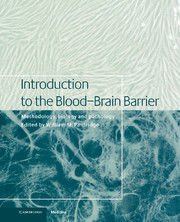Book contents
- Frontmatter
- Contents
- List of contributors
- 1 Blood–brain barrier methodology and biology
- Part I Methodology
- Part II Transport biology
- 18 Biology of the blood–brain glucose transporter
- 19 Glucose transporters in mammalian brain development
- 20 Blood–brain barrier amino acid transport
- 21 P-glycoprotein, a guardian of the brain
- 22 Blood–brain barrier ion transport
- 23 Ion channels in endothelial cells
- 24 Interactions of lipoproteins with the blood–brain barrier
- 25 Fatty acid and lipid intermediate transport
- 26 Blood–brain barrier transport of drugs
- Part III General aspects of CNS transport
- Part IV Signal transduction/biochemical aspects
- Part V Pathophysiology in disease states
- Index
25 - Fatty acid and lipid intermediate transport
from Part II - Transport biology
Published online by Cambridge University Press: 10 December 2009
- Frontmatter
- Contents
- List of contributors
- 1 Blood–brain barrier methodology and biology
- Part I Methodology
- Part II Transport biology
- 18 Biology of the blood–brain glucose transporter
- 19 Glucose transporters in mammalian brain development
- 20 Blood–brain barrier amino acid transport
- 21 P-glycoprotein, a guardian of the brain
- 22 Blood–brain barrier ion transport
- 23 Ion channels in endothelial cells
- 24 Interactions of lipoproteins with the blood–brain barrier
- 25 Fatty acid and lipid intermediate transport
- 26 Blood–brain barrier transport of drugs
- Part III General aspects of CNS transport
- Part IV Signal transduction/biochemical aspects
- Part V Pathophysiology in disease states
- Index
Summary
Introduction
Palmitate, docosahexaenoate and arachidonate
The knowledge about the fatty acid (FA) transport through microcapillary barriers is increasing nowadays. The basis upon which studies are built is the assumption that FAs enter the brain across blood–brain barrier (BBB) from blood circulation (Pardridge and Mietus, 1980; Spector, 1992). They are also distributed to the posterior segment tissues through the blood–retina barrier (BRB) via the retinal or choroidal vessels and pigment epithelium (RPE) (Li et al., 1992). In the plasma, there are many vehicles that deliver FAs to cells. Endocytosed lipoproteins are the major source, and free fatty acids (FFA) bound to albumin constitute a much smaller pool. At first sight, the process of cellular FA uptake and sorting from this pool should include release from albumin complexes at the luminal endothelial surface and transport to intracellular organelles or abluminal membrane. The last step might be facilitated by cytosolic fatty acidbinding proteins (Schoentgen et al., 1989). However, we are still lacking strong evidence for or against the idea that one integral protein might serve either as receptor for FA–albumin complexes or carrier for unbound fatty acids at BRB and BBB level. More controversial is whether or not there is a saturable, energy-independent endothelial transporter or simply transendothelial passive exchange (Kimes et al., 1985).
- Type
- Chapter
- Information
- Introduction to the Blood-Brain BarrierMethodology, Biology and Pathology, pp. 227 - 237Publisher: Cambridge University PressPrint publication year: 1998



